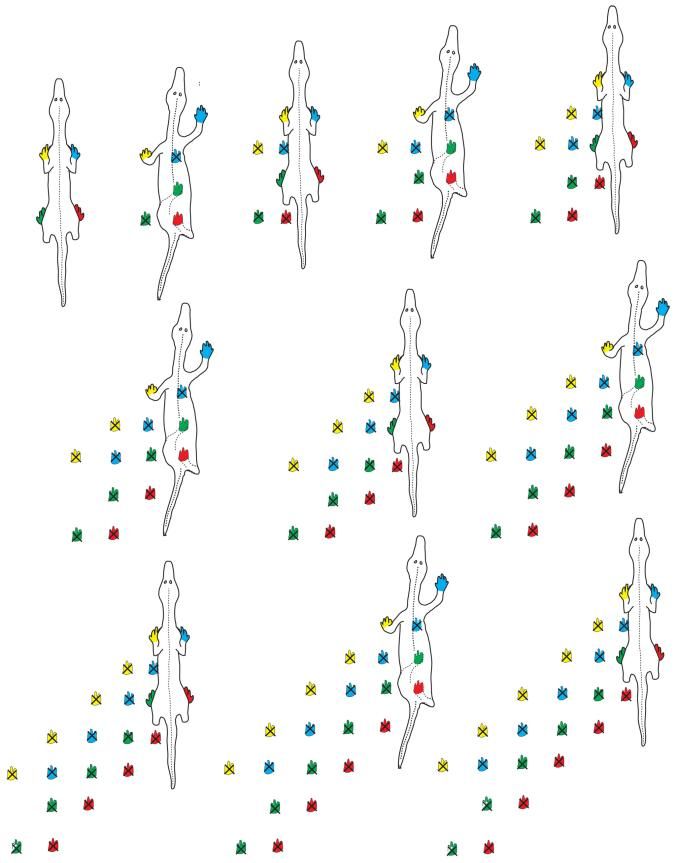The Grand Canyon’s Oldest Footprints Are 310 Million Years Old
Researcher Stephen Rowland says the creature that left the tracks was “doing a funny little side-walking step, line-dance kind of thing”
/https://tf-cmsv2-smithsonianmag-media.s3.amazonaws.com/filer/c9/94/c9947f05-f54c-4fc4-8ba7-549a2b7fcf76/01_ancient_footprints_manakacha-trackway-march-2018-46-adapt11901.jpg)
Some 310 million years ago, a reptile-like creature with an unusual gait roamed the sandy expanses of the Grand Canyon, leaving a trail of 28 footprints that can still be seen today. As Michael Greshko reports for National Geographic, these unusually well-preserved markers represent the national park’s oldest footfalls—and, if additional analysis links the early reptile to one that left a similar set of prints in Scotland roughly 299 million years ago, the tracks may even earn the distinction of being the oldest of their kind by more than 10 million years.
A paleontologist hiking the Grand Canyon’s Bright Angel Trail with a group of students happened upon the footprints in 2016. The animal’s path, which hardened into sandstone soon after its creator scurried off, had previously been hidden inside of a boulder. When the rock fell and split open, the winding trail was finally exposed, enabling the hikers to spot it as they explored the Arizona canyon.
The scientist reported the find to a fellow paleontologist, Stephen Rowland of the University of Nevada, Las Vegas, and in March of this year, Rowland and geologist Mario Caputo of San Diego State University arrived at the scene to investigate further. The pair announced their preliminary findings, soon to be followed up with a formal scientific study, at this month’s Society of Vertebrate Paleontology’s Annual Meeting.
According to Rowland and Caputo’s presentation abstract, the broken quartz boulder preserved the reptilian creature’s footprints as both impressions and natural casts measuring an overall width of about one meter across. Oddly enough, the tracks appear to represent a diagonal gait, as individual footfalls are angled 40 degrees out from the main pathway.
“Even if it was an ordinary trackway, it would be unusual,” Rowland tells Greshko. “But in this case, it's doing a funny little side-walking step, line-dance kind of thing, which is weird.”
There are a number of potential explanations for the ancient animal’s strange gait. Perhaps a strong wind was blowing from the west, pushing the animal right as it attempted to push forward. Or maybe the creature purposefully angled its walk, hoping to steady itself on the slippery surface of a sand dune.

It’s unclear what species the animal belonged to, but the scientists write that they “tentatively” assign the tracks to a “basal tetrapod of unknown taxonomic affinity” and the ichnogenus (category of trace fossil) Chelichnus, which is all basically a very science-y way to say we don't quite know what this is, but we know it had four legs.
As researchers Patrick J. McKeever and Harmut Haubold explained in a 1996 article for the Journal of Paleontology, the Chelichnus classification was first used to describe a set of tracks found in Scotland’s Permian of Dumfries and Galloway during the early 19th century.
Unfortunately, McKeever and Haubold note, “Trackways that represent variations by the same trackmaker due to gait or substrate have been assigned different names. This practice has led to widespread confusion in the area of Permian vertebrate ichnology.”
Still, if Rowland and Caputo’s new identification proves accurate, the Grand Canyon footprints may well be the oldest left by members of the mysterious group.
“With a skeleton with bones and teeth, you get lots of good information, but you don't actually see behavior,” Rowland says to Greshko.
Luckily, he concludes, “we've captured this animal walking.”
/https://tf-cmsv2-smithsonianmag-media.s3.amazonaws.com/accounts/headshot/mellon.png)
/https://tf-cmsv2-smithsonianmag-media.s3.amazonaws.com/accounts/headshot/mellon.png)